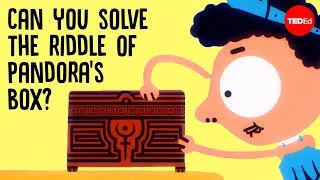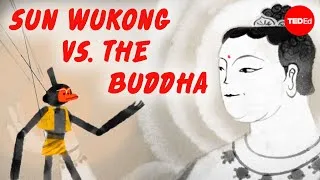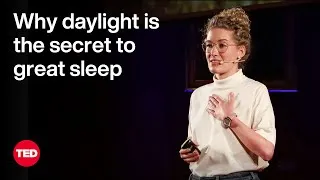請雙擊下方英文字幕播放視頻。
譯者: Lilian Chiu
審譯者: Helen Chang
00:07
Consider the spot where you’re sitting.
0
7420
2360
想像你現在所坐的這個點。
00:09
Travel backwards in time
1
9780
1860
時間旅行回到過去,
00:11
and it might’ve been submerged at
the bottom of a shallow sea,
2
11640
3860
這個點有可能是位在
一片淺海的底部,
00:15
buried under miles of rock,
3
15500
1790
被數英里的岩石給掩埋,
00:17
or floating through a molten,
infernal landscape.
4
17290
4430
或者漂浮在熱熔的地獄環境。
00:21
But go back far enough—
5
21720
1848
但,如果回到夠久的過去——
00:23
about 4.6 billion years,
6
23568
2930
大約四十六億年前,
00:26
and you’d be in the middle of an enormous
cloud of dust and gas
7
26498
4410
你會身處在塵埃和氣體
構成的巨型雲霧中,
00:30
orbiting a newborn star.
8
30908
3526
繞著新生的星體運轉。
00:34
This is the setting for some of the
biggest, smallest mysteries of physics:
9
34434
5410
這是最大、最小物理學之謎
所發生的環境,這個謎就是:
00:39
the mysteries of cosmic dust bunnies.
10
39844
3566
宇宙塵兔之謎。
00:43
Seemingly empty regions
of space between stars
11
43410
3810
在星體之間,看似
空無一物的宇宙區域,
00:47
actually contain clouds of gas and dust,
12
47220
4130
其實有著氣體和塵埃所形成的雲,
00:51
usually blown there by supernovas.
13
51350
3345
通常是被超級新星炸到那裡去的。
00:54
When a dense cloud reaches a certain
threshold called the Jeans mass,
14
54695
4650
當雲的密度高到達
「金斯質量」這個門檻值時,
00:59
it collapses in on itself.
15
59345
2870
它自己就會崩塌。
01:02
The shrinking cloud rotates faster
and faster, and heats up,
16
62215
4550
縮小的雲會越轉越快速,
溫度跟著上升,
01:06
eventually becoming hot enough to burn
hydrogen in its core.
17
66765
4774
最終熱到足以燃燒
它核心區域的氫。
01:11
At this point a star is born.
18
71539
2590
在這個時點,星體就誕生了。
01:14
As fusion begins in the new star,
19
74129
2560
當新星中的融合開始,
01:16
it sends out jets of gas that blow
off the top and bottom of the cloud,
20
76689
5290
它就會噴射出氣體,
將雲的頂部和底部吹掉,
01:21
leaving behind an orbiting ring of gas
and dust called a protoplanetary disk.
21
81986
6920
留下繞行的環狀氣體和塵埃,
稱為「原行星盤」。
01:28
This is a surprisingly windy place;
22
88906
3058
這個地方風大得驚人;
01:31
eddies of gas carry particles apart,
and send them smashing into each other.
23
91964
4980
氣體旋渦會把粒子帶開,
讓它們互相碰撞。
01:36
The dust consists of tiny metal fragments,
bits of rock, and, further out, ices.
24
96944
6623
塵埃包含了小型的
金屬碎片、小堆岩石,
在更外圍還有冰。
01:43
We’ve observed thousands of these disks
in the sky,
25
103567
3124
我們已經觀察到天空中
有數千個這種星盤,
01:46
at various stages of development
26
106691
2260
處在不同的發展階段,
01:48
as dust clumps together
into larger and larger masses.
27
108951
4810
塵埃結在一起,質量越來越大。
01:53
Dust grains 100 times smaller than the
width of a human hair stick to each other
28
113761
5640
比人類頭髮的寬度還要小一百倍的
塵埃粒子會彼此黏在一起,
01:59
through what’s called
the van der Waals force.
29
119401
2920
讓它們相黏的力量
叫做「凡得瓦爾力」。
02:02
That’s where a cloud of electrons
shifts to one side of a molecule,
30
122321
4390
此時,電子雲就會
轉移到分子的一邊,
02:06
creating a negative charge on one end,
and a positive charge on the other.
31
126716
4830
在一端創造出負電荷,
另一端創造出正電荷。
02:11
Opposites attract, but van der Waals can
only hold tiny things together.
32
131546
5300
異性相吸,但凡得瓦爾力只能夠
將微小的東西結合在一起。
02:16
And there’s a problem: once dust
clusters grow to a certain size,
33
136846
4310
有一個問題:一旦塵埃群
成長到了某個大小之後,
02:21
the windy atmosphere of a disk should
constantly break them up
34
141156
3906
星盤大氣中的風很大,
經常使這些塵埃群彼此相撞而散開。
02:25
as they crash into each other.
35
145062
1920
02:26
The question of how they continue to grow
is the first mystery of dust bunnies.
36
146982
6210
它們如何持續成長,
是塵兔的第一個謎。
02:33
One theory looks to electrostatic charge
to answer this.
37
153192
4225
有個從靜電電荷來解答的理論。
02:37
Energetic gamma rays, x-rays,
and UV photons
38
157417
4119
高能加馬射線、X 光、UV 光子
02:41
knock electrons off of gas
atoms within the disk,
39
161536
3754
在星盤中將電子
從氣體原子中打掉,
02:45
creating positive ions
and negative electrons.
40
165290
3815
創造出正離子和負電子,
02:49
Electrons run into and stick to dust,
41
169105
3020
電子碰到塵埃就會黏住塵埃,
02:52
making it negatively charged.
42
172125
2310
讓它帶負電。
02:54
Now, when the wind pushes
clusters together,
43
174435
3020
當風把塵埃群推到一起時,
02:57
like repels like
and slows them down as they collide.
44
177455
4840
同性相斥,且當它們
相撞時會讓它們慢下來。
03:02
With gentle collisions
they won’t fragment,
45
182295
2620
輕輕碰撞不會讓它們破碎,
03:04
but if the repulsion is too strong,
they’ll never grow.
46
184915
3770
但如果相斥太強,
它們就永遠不會成長。
03:08
One theory suggests that high energy
particles
47
188685
3330
有一種理論指出,高能粒子
03:12
can knock more electrons off of some
dust clumps,
48
192015
3520
能把更多電子從塵埃團中給除去,
03:15
leaving them positively charged.
49
195535
2280
讓塵埃團帶正電。
03:17
Opposites again attract,
and clusters grow rapidly.
50
197815
4880
異性相吸,塵埃群就會快速成長。
03:22
But before long we reach
another set of mysteries.
51
202695
3630
但,不久,我們又
碰到了另一組謎。
03:26
We know from evidence found in meteorites
52
206325
2650
從隕石找到的證據顯示,
03:28
that these fluffy dust bunnies
eventually get heated, melted
53
208975
4370
這些蓬鬆的塵兔最終
會被加溫、熔化,
03:33
and then cooled into solid
pellets called chondrules.
54
213345
5267
接著冷卻,成為固態顆粒,
叫做隕石球粒。
03:38
And we have no idea how
or why that happens.
55
218612
3978
我們不知道這是怎麼發生的,
也不知道為什麼發生。
03:42
Furthermore, once those pellets do form,
how do they stick together?
56
222590
4880
此外,一旦那些顆粒真的形成了,
它們要如何黏在一起?
03:47
The electrostatic forces from before
are too weak,
57
227470
3510
之前的靜電力太弱了,
03:50
and small rocks can’t be held together
by gravity either.
58
230980
4320
小岩石無法靠引力就結合在一起。
03:55
Gravity increases proportionally to the
mass of the objects involved.
59
235300
4950
物體間的引力
和物體的質量成正比。
04:00
That’s why you could effortlessly escape
an asteroid the size of a small mountain
60
240251
4940
那就是為什麼你可以毫不費力,
光靠雙腿產生的力量,
04:05
using just the force generated
by your legs.
61
245191
3390
就脫離小山大小的小行星。
04:08
So if not gravity, then what?
62
248581
2970
如果不是引力,那是什麼?
04:11
Perhaps it’s dust.
63
251551
2180
也許是塵埃。
04:13
A fluffy dust rim collected around the
outside of the pellets
64
253731
4190
在顆粒外部集結的蓬鬆塵埃外緣
04:17
could act like Velcro.
65
257921
1825
可能會有魔鬼沾的功能。
04:19
There’s evidence for this in meteors,
66
259746
2620
在隕石中有找到相關證據,
04:22
where we find many chondrules surrounded
by a thin rim of very fine material–
67
262366
5750
我們發現許多隕石球粒被薄薄一層
非常好的材質給包住——
04:28
possibly condensed dust.
68
268116
3353
有可能是高密度的塵埃。
04:31
Eventually the chondrule pellets get
cemented together inside larger rocks,
69
271469
5310
最終,隕石球粒的顆粒會在
更大的岩石中被黏結起來,
04:36
which at about 1 kilometer across
70
276779
2480
這些岩石大約有一公里寬,
04:39
are finally large enough to hold
themselves together through gravity.
71
279259
4630
終於,這些顆粒因此就夠大,
足以用引力持續結合在一起了。
04:43
They continue to collide and grow
into larger and larger bodies,
72
283889
4600
它們繼續碰撞,
成長成更大的物體,
04:48
including the planets we know today.
73
288489
2718
包括我們現今所知的行星。
04:51
Ultimately, the seeds of
everything familiar–
74
291207
3150
最終,我們熟悉的一切——
04:54
the size of our planet, its position
within the solar system,
75
294357
3090
我們行星的大小,
在太陽系中的位置,
04:57
and its elemental composition–
76
297447
2490
以及組成的元素——
04:59
were determined by an uncountably large
series of random collisions.
77
299937
5856
其根源是由一大連串
隨機撞擊所決定的。
05:05
Change the dust cloud just a bit,
78
305793
2387
若塵雲有稍微改變一點點,
05:08
and perhaps the conditions wouldn’t
have been right
79
308180
2630
也許就不會有對的條件
05:10
for the formation of life on our planet.
80
310810
2790
讓我們的星球上出現生命了。
New videos
Original video on YouTube.com
關於本網站
本網站將向您介紹對學習英語有用的 YouTube 視頻。 您將看到來自世界各地的一流教師教授的英語課程。 雙擊每個視頻頁面上顯示的英文字幕,從那裡播放視頻。 字幕與視頻播放同步滾動。 如果您有任何意見或要求,請使用此聯繫表與我們聯繫。







